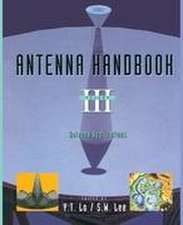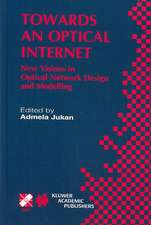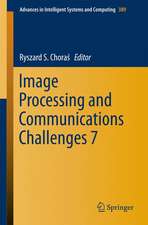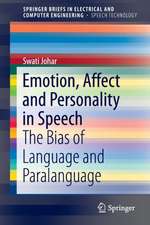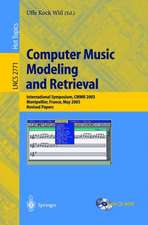Blind Speech Separation: Signals and Communication Technology
Editat de Shoji Makino, Te-Won Lee, Hiroshi Sawadaen Limba Engleză Hardback – 20 sep 2007
| Toate formatele și edițiile | Preț | Express |
|---|---|---|
| Paperback (1) | 951.77 lei 6-8 săpt. | |
| SPRINGER NETHERLANDS – 30 noi 2010 | 951.77 lei 6-8 săpt. | |
| Hardback (1) | 958.07 lei 6-8 săpt. | |
| SPRINGER NETHERLANDS – 20 sep 2007 | 958.07 lei 6-8 săpt. |
Din seria Signals and Communication Technology
- 18%
 Preț: 952.89 lei
Preț: 952.89 lei - 18%
 Preț: 1559.80 lei
Preț: 1559.80 lei - 17%
 Preț: 361.80 lei
Preț: 361.80 lei - 18%
 Preț: 811.61 lei
Preț: 811.61 lei - 15%
 Preț: 585.26 lei
Preț: 585.26 lei - 18%
 Preț: 727.97 lei
Preț: 727.97 lei - 15%
 Preț: 585.90 lei
Preț: 585.90 lei -
 Preț: 393.35 lei
Preț: 393.35 lei - 20%
 Preț: 1002.73 lei
Preț: 1002.73 lei - 15%
 Preț: 641.71 lei
Preț: 641.71 lei - 20%
 Preț: 338.92 lei
Preț: 338.92 lei - 18%
 Preț: 1579.66 lei
Preț: 1579.66 lei - 18%
 Preț: 896.08 lei
Preț: 896.08 lei - 18%
 Preț: 847.11 lei
Preț: 847.11 lei - 18%
 Preț: 1234.77 lei
Preț: 1234.77 lei - 18%
 Preț: 905.54 lei
Preț: 905.54 lei - 15%
 Preț: 646.43 lei
Preț: 646.43 lei - 20%
 Preț: 662.48 lei
Preț: 662.48 lei - 15%
 Preț: 641.20 lei
Preț: 641.20 lei - 18%
 Preț: 1847.84 lei
Preț: 1847.84 lei - 18%
 Preț: 946.24 lei
Preț: 946.24 lei - 18%
 Preț: 1241.10 lei
Preț: 1241.10 lei - 20%
 Preț: 649.43 lei
Preț: 649.43 lei - 20%
 Preț: 993.28 lei
Preț: 993.28 lei - 18%
 Preț: 940.57 lei
Preț: 940.57 lei - 18%
 Preț: 1389.30 lei
Preț: 1389.30 lei - 20%
 Preț: 1003.50 lei
Preț: 1003.50 lei - 18%
 Preț: 953.52 lei
Preț: 953.52 lei - 20%
 Preț: 1001.16 lei
Preț: 1001.16 lei - 18%
 Preț: 1415.36 lei
Preț: 1415.36 lei - 15%
 Preț: 653.33 lei
Preț: 653.33 lei - 15%
 Preț: 645.60 lei
Preț: 645.60 lei - 15%
 Preț: 637.28 lei
Preț: 637.28 lei - 18%
 Preț: 948.79 lei
Preț: 948.79 lei - 18%
 Preț: 945.62 lei
Preț: 945.62 lei - 18%
 Preț: 836.36 lei
Preț: 836.36 lei - 18%
 Preț: 1225.46 lei
Preț: 1225.46 lei - 15%
 Preț: 635.01 lei
Preț: 635.01 lei - 15%
 Preț: 639.25 lei
Preț: 639.25 lei - 15%
 Preț: 646.30 lei
Preț: 646.30 lei - 15%
 Preț: 639.25 lei
Preț: 639.25 lei - 15%
 Preț: 712.36 lei
Preț: 712.36 lei - 20%
 Preț: 1006.12 lei
Preț: 1006.12 lei - 18%
 Preț: 970.56 lei
Preț: 970.56 lei
Preț: 958.07 lei
Preț vechi: 1168.38 lei
-18% Nou
Puncte Express: 1437
Preț estimativ în valută:
183.33€ • 196.04$ • 152.85£
183.33€ • 196.04$ • 152.85£
Carte tipărită la comandă
Livrare economică 18 aprilie-02 mai
Preluare comenzi: 021 569.72.76
Specificații
ISBN-13: 9781402064784
ISBN-10: 1402064780
Pagini: 432
Ilustrații: XVI, 432 p.
Dimensiuni: 155 x 235 x 25 mm
Greutate: 0.81 kg
Ediția:2007
Editura: SPRINGER NETHERLANDS
Colecția Springer
Seria Signals and Communication Technology
Locul publicării:Dordrecht, Netherlands
ISBN-10: 1402064780
Pagini: 432
Ilustrații: XVI, 432 p.
Dimensiuni: 155 x 235 x 25 mm
Greutate: 0.81 kg
Ediția:2007
Editura: SPRINGER NETHERLANDS
Colecția Springer
Seria Signals and Communication Technology
Locul publicării:Dordrecht, Netherlands
Public țintă
ResearchCuprins
Multiple Microphone Blind Speech Separation with ICA.- Convolutive Blind Source Separation for Audio Signals.- Frequency-Domain Blind Source Separation.- Blind Source Separation using Space–Time Independent Component Analysis.- TRINICON-based Blind System Identification with Application to Multiple-Source Localization and Separation.- SIMO-Model-Based Blind Source Separation – Principle and its Applications.- Independent Vector Analysis for Convolutive Blind Speech Separation.- Relative Newton and Smoothing Multiplier Optimization Methods for Blind Source Separation.- Underdetermined Blind Speech Separation with Sparseness.- The DUET Blind Source Separation Algorithm.- K-means Based Underdetermined Blind Speech Separation.- Underdetermined Blind Source Separation of Convolutive Mixtures by Hierarchical Clustering and L1-Norm Minimization.- Bayesian Audio Source Separation.- Single Microphone Blind Speech Separation.- Monaural Source Separation.- Probabilistic Decompositions of Spectra for Sound Separation.- Sparsification for Monaural Source Separation.- Monaural Speech Separation by Support Vector Machines: Bridging the Divide Between Supervised and Unsupervised Learning Methods.
Notă biografică
Dr. Shoji Makino is an IEEE Fellow, Associate Editor of the IEEE Transactions on Speech & Audio Processing, and Executive Manager NTT Communication Science Laboratories. Dr. Makino was also co-editor on the succesful 2005 Springer book: Benesty - Speech Enhancement.
Textul de pe ultima copertă
This is the first book to provide a cutting edge reference to the fascinating topic of blind source separation (BSS) for convolved speech mixtures. Through contributions by the foremost experts on the subject, the book provides an up-to-date account of research findings, explains the underlying theory, and discusses potential applications. The individual chapters are designed to be tutorial in nature with specific emphasis on an in-depth treatment of state of the art techniques.
Blind Speech Separation is divided into three parts:
Part 1 presents overdetermined or critically determined BSS. Here the main technology is independent component analysis (ICA). ICA is a statistical method for extracting mutually independent sources from their mixtures. This approach utilizes spatial diversity to discriminate between desired and undesired components, i.e., it reduces the undesired components by forming a spatial null towards them. It is, in fact, a blind adaptive beamformer realized by unsupervised adaptive filtering.
Part 2 addresses underdetermined BSS, where there are fewer microphones than source signals. Here, the sparseness of speech sources is very useful; we can utilize time-frequency diversity, where sources are active in different regions of the time-frequency plane.
Part 3 presents monaural BSS where there is only one microphone. Here, we can separate a mixture by using the harmonicity and temporal structure of the sources. We can build a probabilistic framework by assuming a source model, and separate a mixture by maximizing the a posteriori probability of the sources.
Blind Speech Separation is divided into three parts:
Part 1 presents overdetermined or critically determined BSS. Here the main technology is independent component analysis (ICA). ICA is a statistical method for extracting mutually independent sources from their mixtures. This approach utilizes spatial diversity to discriminate between desired and undesired components, i.e., it reduces the undesired components by forming a spatial null towards them. It is, in fact, a blind adaptive beamformer realized by unsupervised adaptive filtering.
Part 2 addresses underdetermined BSS, where there are fewer microphones than source signals. Here, the sparseness of speech sources is very useful; we can utilize time-frequency diversity, where sources are active in different regions of the time-frequency plane.
Part 3 presents monaural BSS where there is only one microphone. Here, we can separate a mixture by using the harmonicity and temporal structure of the sources. We can build a probabilistic framework by assuming a source model, and separate a mixture by maximizing the a posteriori probability of the sources.
Caracteristici
cutting edge topic on blind source separation top researchers from all over the world tutorial in nature and in-depth treatment


